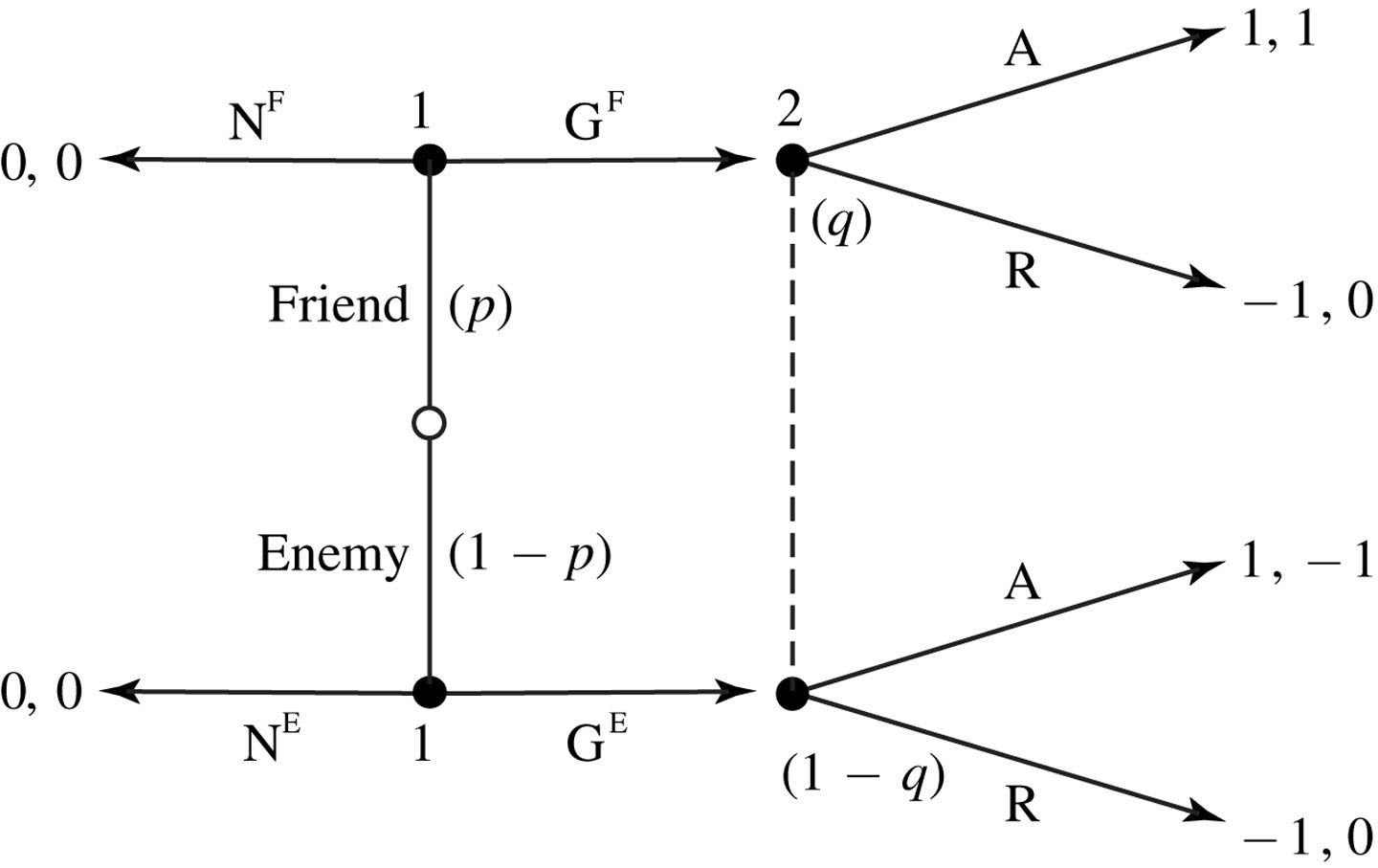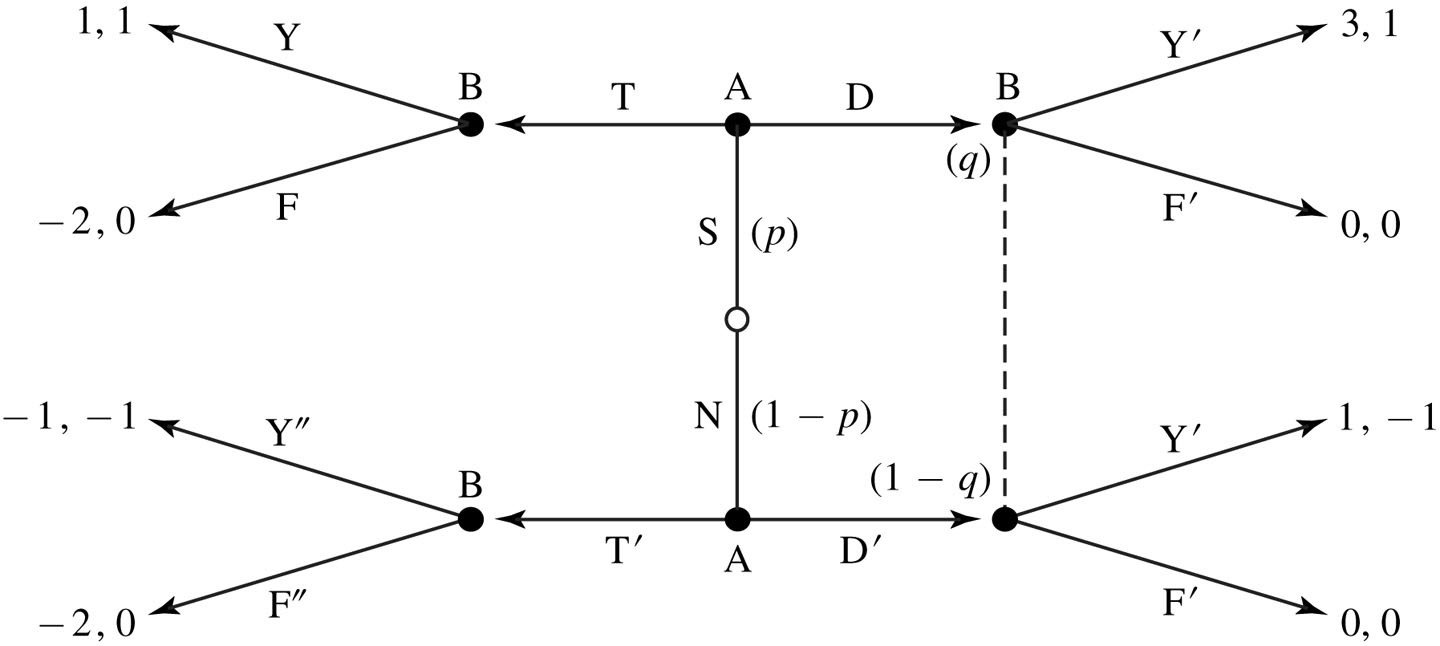Perfect Bayesian Equilibrium
To navigate: press "N" to move forward and "P" to move back.
To see an outline, press "ESC". Topics are arranged in columns.
Today's Agenda
Part 1: Perfect Bayesian Equilibrium
Part 2: Separating and Pooling
Bayes' Rule and Conditional Beliefs
Sequential Rationality and Consistency of Beliefs
Guided exercise from Watson
Bayes' Rule and Conditional Beliefs


Suppose you don't know whether it's raining out,
but you can observe whether I'm carrying an umbrella or not.
Ex ante, you believe the joint probabilities of these events
are given by this table:
Bayes' Rule:
Before you see whether I'm carrying an umbrella, with what probability do you believe it's raining?
Suppose you see me with an umbrella. Now with what probability do you think it's raining?



Suppose player 2's payoffs were as shown.
If player 3 comes to the information set, what should their beliefs be?
Sequential Rationality and Consistency of Beliefs

"Gift Giving Game"
Nature determines whether player 1 is a "friend" or "enemy" to player 2.
Player 1, knowing their type, can decide to give a gift to player 2 or not.
If player 1 gives a gift, player 2 can choose to accept it or not. Player 2 wants to accept a gift from a friend, but not from an enemy.
Whenever a player reaches an information set, they have some updated beliefs over which node they are.
Based on these beliefs, they should choose the action that maximizes their expected payoff.

In equilibrium, players' beliefs should be consistent with the strategies being played.

What is \(q\) if player 1 plays \(G^FN^E\)?
What is \(q\) if player 1 plays \(N^FG^E\)?
What is \(q\) if player 1 plays \(G^FG^E\)?
What is \(q\) if player 1 plays \(N^FN^E\)?
What if there were three types?
Calculating \(q\) in general:

Let \(r^F\) be the probability that
Nature selects F and player 1 selects G.
Let \(r^E\) be the probability that
Nature selects E and player 1 selects G.
Suppose there are 3 types, and two choose to give?
Definition: Perfect Bayesian Equilibrium (PBE)
Consider a strategy profile for the players, as well as beliefs over the nodes at all information sets.
(1) each player's strategy specifies optimal actions, given his beliefs
These are called a perfect Bayesian equilibrium (PBE) if:
(2) the beliefs are consistent with Bayes' rule wherever possible
More simply: strategies must be optimal given beliefs, and
beliefs must be consistent with the strategies being played.
Separating and Pooling Equilibria
A perfect Bayesian equilibrium consists of
strategy profiles for the players
AND
beliefs over nodes at all information sets
SUCH THAT
(1) each player's strategy specifies optimal actions, given their beliefs
(2) beliefs are consistent with Bayes' rule wherever possible
Separating and Pooling Equilibria
Separating Equilibrium: Each type of informed player chooses differently,
thereby conveying information about their type to the uninformed player
Pooling Equilibrium: Each type of informed player chooses the same,
thereby leaving the uninformed player with their prior belief.
Steps for calculating perfect Bayesian equilibria:
- Start with a strategy for player 1 (pooling or separating).
- If possible, calculate updated beliefs (q in the example) by using Bayes’ rule.
In the event that Bayes’ rule cannot be used, you must arbitrarily select an updated belief;
here you will generally have to check different potential values for the updated belief
with the next steps of the procedure. - Given the updated beliefs, calculate player 2’s optimal action.
- Check whether player 1’s strategy is a best response to player 2’s strategy.
If so, you have found a PBE.

Guided Exercise from Watson (p. 385)
Amy wants Brenda to take her to the mall
(choose Y rather than F)
Brenda only wants to go
if her favorite shoes are on sale
(nature has chosen S rather than N)
Amy has access to a newspaper that shows whether the shows are on sale or not
(knows Nature's move);
she can choose to
take the newspaper (T) or not (D). Taking the newspaper reduces her payoff by 2.
Find the separating and pooling equilibria of the game.